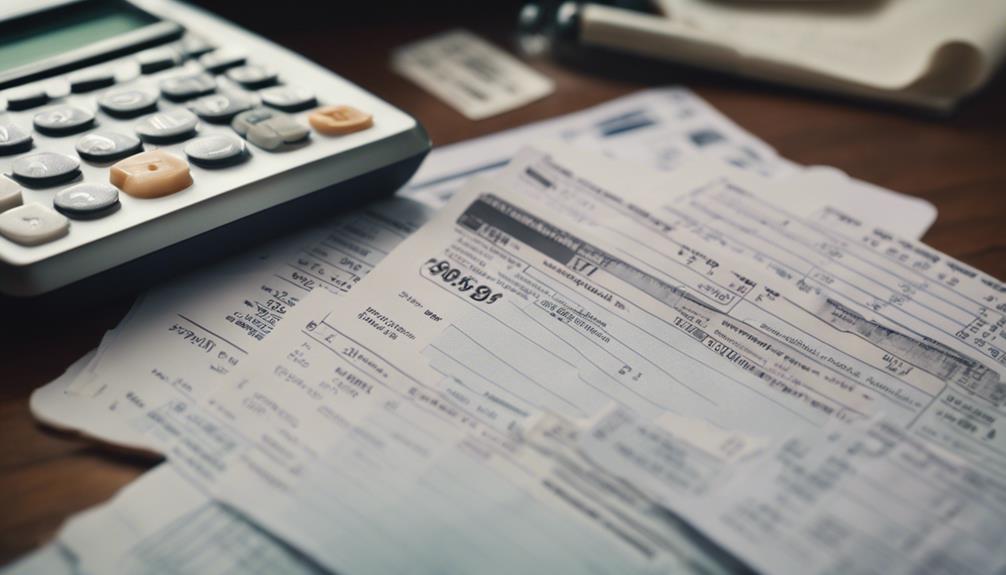To lower your tax bill, maximize deductions like business, medical, educational, and charitable expenses. Keep detailed records for accurate claims. Utilize retirement contributions and Health Savings Accounts for immediate savings. Explore tax credits like the Earned Income Tax Credit and the Child Tax Credit. Understand tax laws and seek professional advice for effective tax reduction. Invest smartly in municipal bonds and long-term gains for tax efficiency. Maximize retirement contributions and explore education tax benefits. Stay informed on tax strategies to optimize savings.
Key Takeaways
- Utilize deductions for business, medical, educational, and charitable expenses.
- Maximize retirement contributions to lower taxable income.
- Consider tax credits like the Earned Income Tax Credit and Child Tax Credit.
- Explore tax-efficient investments such as municipal bonds and long-term capital gains.
- Stay informed of tax laws to optimize tax-saving strategies.
Deductions for Lower Tax Bill

Wondering how deductions can help lower your tax bill? Tax deductions are a powerful tool to reduce your taxable income and ultimately decrease the amount you owe to the government. By itemizing deductions such as business expenses, medical expenses, educational expenses, and charitable contributions, you can lower your tax bill significantly. When your total deductions exceed the standard deduction, itemizing becomes a strategic way to maximize your tax savings.
Keeping detailed records of your expenses is essential to claim deductions accurately. For business expenses, make sure you have receipts and documentation to support your claims. Medical expenses, including health insurance premiums and out-of-pocket costs, can also be deducted to reduce your taxable income. Educational expenses, such as tuition fees and textbooks, are eligible for deductions as well.
Charitable contributions to qualified organizations are another pathway to lower your tax bill. By leveraging these deductions effectively, you can optimize your tax savings and keep more money in your pocket.
Strategies for Tax Savings

To maximize your tax savings, consider implementing various strategies that can help lower your taxable income and reduce the amount you owe to the government.
Here are some effective strategies for tax savings:
- Utilize retirement contributions, such as traditional 401(k) and IRA contributions, to decrease taxable income.
- Consider opening a Health Savings Account (HSA) for immediate tax deductions and tax-free withdrawals for medical expenses.
- Take advantage of Flexible Spending Accounts (FSAs) at work for tax-free payment of medical and dependent care expenses.
- Claim business deductions for self-employed individuals, including expenses like vehicle mileage, advertising, and office supplies.
- Explore the home office deduction by deducting a portion of rent and utility fees for exclusive business use of space.
Popular Tax Breaks and Credits

For individuals seeking to maximize their tax savings, it is essential to explore popular tax breaks and credits available to eligible taxpayers. Some key tax credits include the Earned Income Tax Credit (EITC), which benefits low to moderate-income individuals and families, and the Child Tax Credit, providing up to $2,000 per qualifying child under 17. Additionally, the American Opportunity Tax Credit supports education by offering up to $2,500 per student for the first four years of post-secondary education. The Child and Dependent Care Credit can help cover expenses for child or dependent care, while the Saver's Credit rewards contributions to retirement accounts for low to moderate-income individuals.
| Tax Credits | Description | Maximum Amount |
|---|---|---|
| Earned Income Tax Credit | For low to moderate-income working individuals and families | Varies based on income |
| Child Tax Credit | Provides up to $2,000 per qualifying child under 17, with $1,400 being refundable | $2,000 |
| American Opportunity Tax Credit | Offers up to $2,500 per student for the first four years of post-secondary education | $2,500 |
Legal Tax Reduction Secrets

Explore advanced tax planning strategies to legally reduce your tax burden while maximizing your savings. Here are some legal tax reduction secrets to help you optimize your tax-saving potential:
- Maximize Deductions and Credits: Guarantee you take full advantage of all available deductions and credits to reduce your taxable income.
- Understand Tax Laws: Stay informed about tax laws and regulations to make informed decisions and benefit from available tax breaks.
- Seek Professional Advice: Consult with tax professionals to guarantee compliance with tax reduction techniques and maximize your savings.
- Utilize Tax Reduction Strategies: Implement proven tax reduction strategies to minimize your tax bill effectively.
- Stay Informed: Keep yourself updated on changes in tax laws to continuously optimize your tax-saving strategies and take advantage of new opportunities.
Tax-Efficient Investment Tips

Consider investing in municipal bonds for tax-free interest payments as a tax-efficient strategy to earn income while minimizing your tax liabilities. Municipal bonds provide a way to earn interest that's exempt from federal taxes and sometimes state and local taxes, making them a smart choice for tax-conscious investors.
Additionally, look into long-term capital gains for preferential tax rates, as holding investments for over a year can substantially reduce the tax burden on your gains. Health Savings Accounts (HSAs) offer triple tax advantages with tax-deductible contributions, tax-free growth, and tax-free withdrawals for medical expenses, making them a valuable tool for saving on healthcare costs.
Don't overlook fringe benefits such as flexible spending accounts, which can help you save on taxes for qualified medical and dependent care expenses. By diversifying your investment portfolio and utilizing these tax-efficient strategies, you can minimize tax liabilities and maximize returns, ultimately keeping more money in your pocket.
Business and Retirement Strategies

Starting a business offers tax advantages and deductions for eligible expenses, providing opportunities to optimize your financial strategy.
As a business owner, there are several key strategies you can implement to reduce your taxable income and lower your tax bill:
- Maximize Contributions: By maxing out contributions to your retirement plan, you can substantially reduce your taxable income.
- Utilize Health Savings Accounts (HSAs): HSAs provide triple tax advantages and can help you save on healthcare expenses while decreasing your tax bill.
- Explore Fringe Benefits: Look into options like flexible spending accounts to take advantage of tax savings opportunities.
- Leverage Employer Benefits: Take advantage of any employer-provided benefits and deductions to further diminish your tax liability.
- Invest in Employer-Sponsored Retirement Plans: Contributing to these plans not only helps you save for retirement but also offers tax benefits that can diminish your overall tax bill.
Education and Family Tax Benefits

To further optimize your tax strategy, now let's shift our focus to Education and Family Tax Benefits, which offer valuable opportunities to save on expenses related to education and childcare.
The American Opportunity Tax Credit can provide up to $2,500 per student for education expenses, while the Lifetime Learning Credit offers up to $2,000 per tax return for tuition, fees, and books.
If you've been repaying student loans, take advantage of the Student Loan Interest Deduction, allowing a deduction of up to $2,500 for interest paid.
For families, the Child Tax Credit offers up to $2,000 per qualifying child under 17, and the Child and Dependent Care Credit can provide up to $3,000 for one qualifying individual or $6,000 for two or more for dependent care expenses.
Frequently Asked Questions
Can Deductions and Credits Reduce What You Owe in Taxes?
Yes, deductions and credits can reduce what you owe in taxes. Deductions lower taxable income by subtracting expenses, while credits directly lower the tax bill. Understanding and utilizing them effectively can decrease your tax burden to a large extent.
What Reduces Your Tax Bill the Most?
To reduce your tax bill the most, maximize deductions like mortgage interest and charitable contributions, and claim credits such as the Child Tax Credit and Earned Income Tax Credit. Utilize retirement accounts, HSA, and FSA for additional savings.
How to Reduce Taxes Owed to the Irs?
To reduce taxes owed to the IRS, consider strategies like utilizing tax deductions and credits, contributing to retirement accounts, deducting eligible expenses, investing in tax-efficient options, and seeking advice from professionals for maximizing savings.
Do Both Tax Credits and Tax Deductions Reduce Taxable Income?
Yes, both tax credits and tax deductions reduce taxable income. Tax credits directly lower the tax amount owed, while deductions decrease the taxable income amount. Utilizing both can considerably reduce your overall tax liability.
Conclusion
Now that you know how to reduce your tax bill through deductions and credits, take action to maximize your savings. By implementing these strategies and taking advantage of popular tax breaks, you can lower your tax burden to a great extent.
Remember to stay informed about legal tax reduction secrets and consider tax-efficient investment tips for long-term financial success. Investigate the truth of the theory that tax planning can lead to substantial savings and secure your financial future. Also, be sure to take advantage of any available tax deductions and credits, such as those related to retirement savings or education expenses. As a freelancer, it’s essential to stay organized and keep detailed records of all income and expenses to maximize your tax savings. By staying informed and implementing these essential tax tips for freelancers, you can take control of your financial situation and ensure a more stable and secure future.









